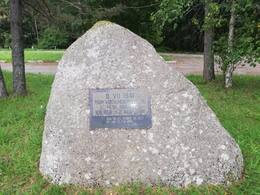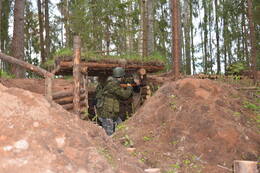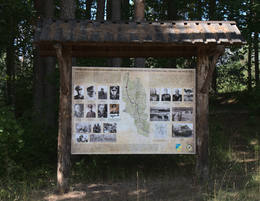Omakaitse II World War II
Omakaitse (Home Guard, Selbstschutz in German) was an internal security organisation in Estonia during the German Occupation from 1941 to 1944.
By June 1941, one year had passed since Estonia had been violently occupied by the Soviet Union, which brought a wave of arrests, deportations and Sovietisation. Seeing the quickly approaching German forces in the first weeks of the invasion of the Soviet Union, thousands of Estonians went into hiding in the woods as so-called Forest Brothers to avoid being drafted by the Red Army and to undermine Soviet authorities. During the temporary power vacuum after the retreat of the Bolshevists and prior to the arrival of the German forces, many Estonian government entities were restored with the groundwork laid for the establishment of a law enforcement structure, later to be named Omakaitse. The internal security organisation comprising mainly former members of the Defence League was tasked with battling destruction battalions and remnants of the Red Army and enforcing the law. Those suspected of having collaborated with Soviet authorities were arrested and some even killed under mob law. German authorities used members of Omakaitse to enact their anti-Semitic extermination policies.
After German forces had occupied Estonia, the German military authorities disbanded Omakaitse and had the Forest Brothers, who had participated in the Summer War of 1941, dismissed, only for the organisation to be resummoned soon after by Commander of the German Army Group North Wilhelm Ritter von Leeb as auxiliary law enforcement (Hilfsschutzmannschaft) under the Estonian Self-Administration. Omakaitse was subordinated to German military and police organisations. Omakaitse comprised volunteer militiamen until October 1943 when it was made compulsory for all men who did not qualify for mobilisation.
Omakaitse was tasked with maintaining internal security and carried out both police and national guard duties, including protecting railways and highways and deterring Soviet paratroopers, surveillance of various sites, tracking escaped POWs, coastal defence and so on.
Related objects
Timmkanal battle site
On 4 July 1941, Forest Brothers stormed the executive committee in Häädemeeste. The group was led by Elmar Toomingas, the headmaster of Metsapoole Primary School and the head of the Häädemeeste regional unit of the Defence League.
On 6 July, a Red Army destruction battalion arrived: some of them were killed, others were taken prisoner.
On 7 July, a combined force of 400 men from Red Army infantry and destruction battalions attacked the local militia, which comprised 60 men. The defenders, with the help of two light tanks, were pushed back to Timmkanal, where they reorganised and took up positions again.
On 8 July, the destruction battalion burnt down 14 farmsteads and the schoolhouse in the village of Rannametsa and the church in Võiste. A battle ensued in Tahkuranna between the advancing Germans and the destruction battalion leaving Rannametsa, which suffered the loss of 57 men, with eight captured. Some sources claim the German unit was the 402nd Cyclist Battalion led by a Major Ullersperger. The Estonian and German units arrived in Pärnu that afternoon. The battle site is marked by a granite boulder adorned with a black tablet that reads: "On 8 July 1941 the destruction battalion of Pärnu burnt down 18 households and the schoolhouse in Rannametsa". The text is followed by a quote from a poem by Hando Runnel.
Defence Line "Walk"
The Valga defence line (Walk) was built along the Väike Emajõe-Koiva river line in early June 1944. The northern part of the line ended at Lake Võrtsjärv and ran from Pikasilla almost all the way to Ligaste Manor, located on the left bank of Väike Emajõgi. The defence line consisted of two defence belts, occasionally reaching a depth of 10-12 kilometres. The front line was covered with barbed wire and mine fields. All bridges on Väike Emajõgi and Koiva rivers were destroyed (though the Pikasilla and Jõgeveste bridges were only destroyed at noon on 26 August) and all bridges behind the defence line were ready to be destroyed. The second line ran along Õhne and Pedeli rivers and defence structures included the cities of Tõrva and Valga that were re-equipped to be points of resistance.
The main line of defence consisted of two sets of trenches, in the most important sections even three to four sets of well-developed trenches with connection systems. To build the defence line, the Germans used Russian prisoners of war and forcefully recruited the local population within Organisation Todt.
Trenches and fire trenches have been restored at the location. The area is used by the Valga Military Theme Park, which led the effort to restore the wartime appearance of the hill. The outdoor space was opened in 2015; the Valga Military Theme Park regularly organises laser weapon battles and other events on site.
The trenches and pillboxes have been restored in the former German fortified positions. The area is operated by the military theme park in Valga, which led the restoration work to revive the ridge's wartime look. The outdoor area, in which laser tag and special events are now held, was opened in 2015.
Pikasilla battle field
This is a part of the defence line Walk. The Valga defence line (Walk) was built along the Väike Emajõe-Koiva river line in early June 1944. The northern part of the line ended at Lake Võrtsjärv and ran from Pikasilla almost all the way to Ligaste Manor, located on the left bank of Väike Emajõgi. The defence line consisted of two defence belts, occasionally reaching a depth of 10-12 kilometres. The front line was covered with barbed wire and mine fields. All bridges on Väike Emajõgi and Koiva rivers were destroyed (though the Pikasilla and Jõgeveste bridges were only destroyed at noon on 26 August) and all bridges behind the defence line were ready to be destroyed.
The Red Army planned the liquidation of the German and Estonian forces located at the Narva front with an attack via Tartu from their back. To conduct the plan, the Red Army 3rd Baltic Front leadership sent four units to the Emajõgi line. Their task was to cross Emajõgi River and, with a circular movement over the northern bank of Lake Võrtsjärv, occupy Northern Estonia with the German 18th Army located at the Narva front. They also planned to break German resistance on the Pikasilla-Valga line and cut off the German path of retreat towards Riga.
In Southern Estonia, the defence consisted of six divisions and smaller units of Wehrmacht’s XXVIII and XXXVIII Army Corps, with the rear defended by the 207th Reinforcement Division. At the beginning of the operation, the Red Army had a numerical advantage in manpower and battle equipment. The German forces mostly consisted of different battle groups and smaller units. The Omakaitse units participating in the defence were poorly equipped and had low battle morale.
On 27 August, the Red Army managed to cross Väike Emajõgi River at Pikasilla and held a small bridge head there. Until 13 September, the German and Estonian Omakaitse division managed to stop the advancing Red Army units on the defence line Walk. On 14 September, the divisions of the 3rd Red Army Baltic Front began their assault, breaking through the line of defence on 17 September.








